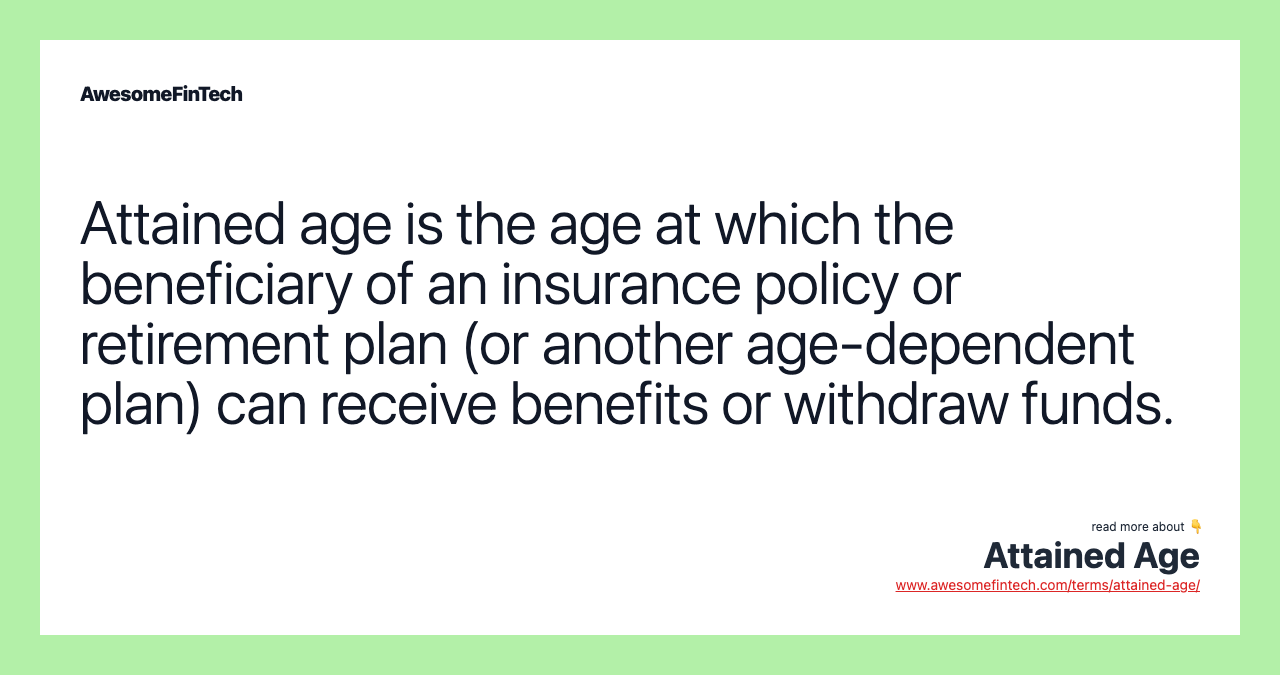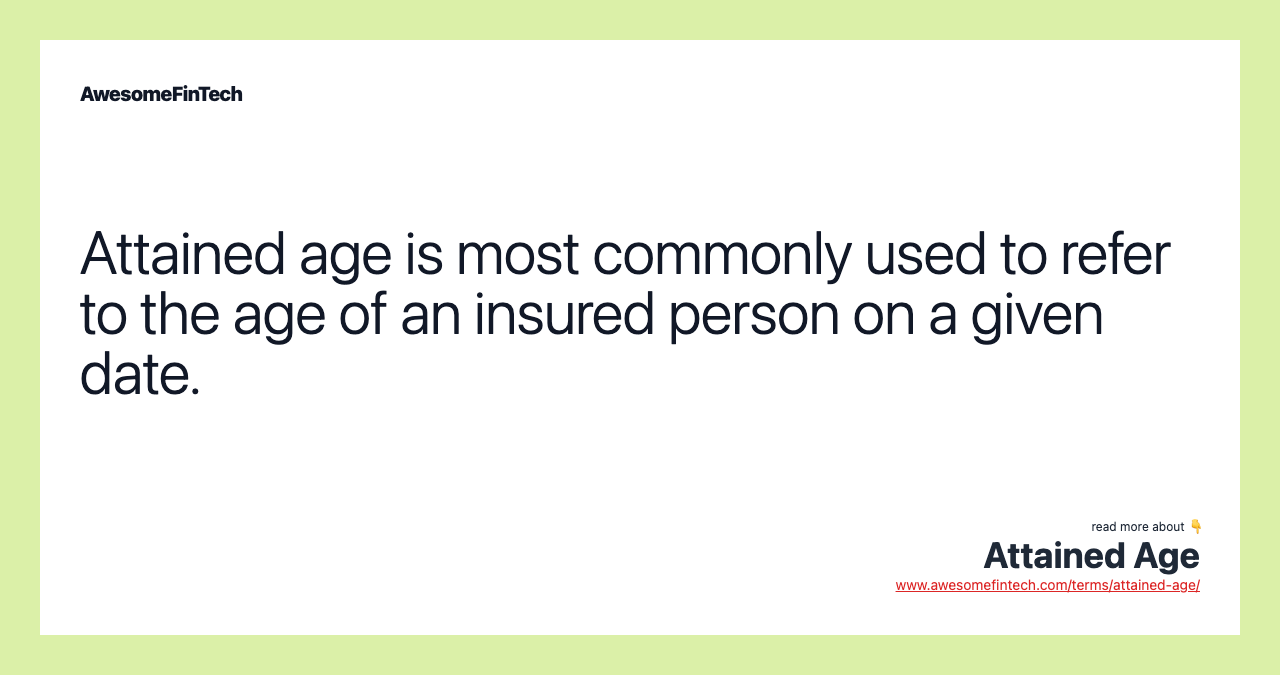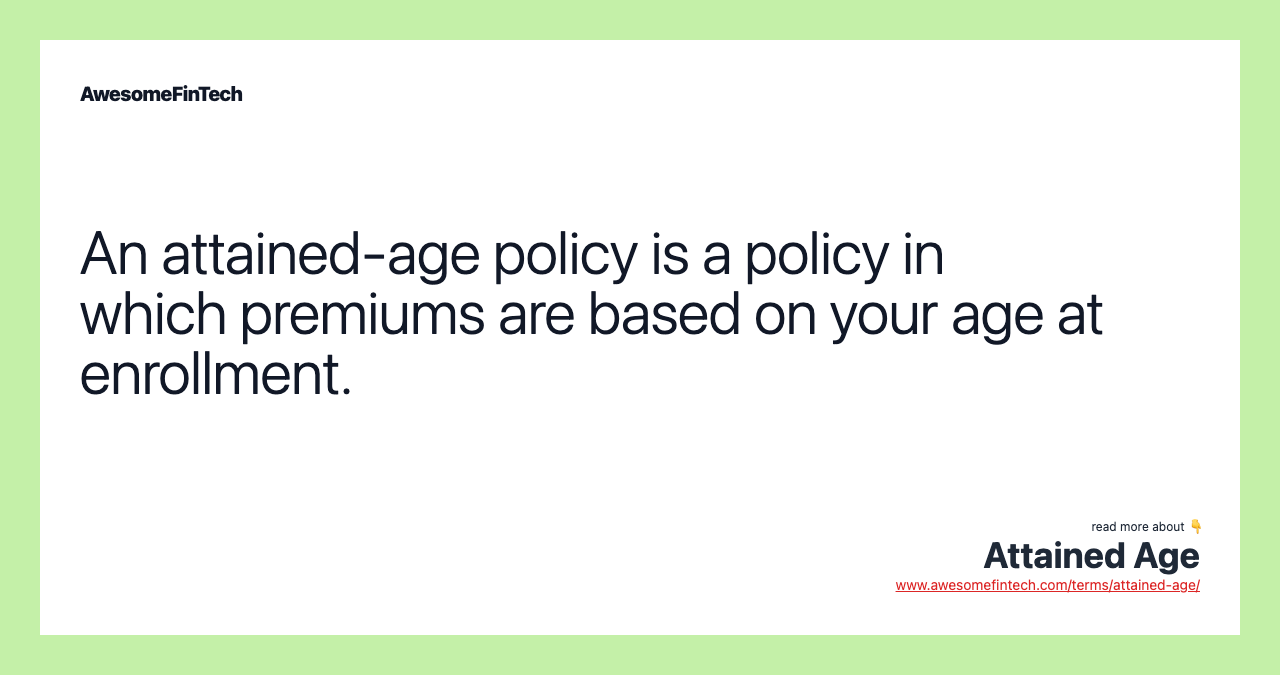Attained Age
Attained age is the age at which the beneficiary of an insurance policy or retirement plan (or another age-dependent plan) can receive benefits or withdraw funds. An attained-age policy is a policy in which premiums are based on your age at enrollment. Attained age can also be used to calculate pricing for insurance policies that set payments according to the policy holder's age, called an attained-age policy. Attained age can also be used to calculate pricing for insurance policies that set payments according to the policy holder's age, called an attained-age policy. Attained age is the age at which the beneficiary of an insurance policy or retirement plan (or another age-dependent plan) can receive benefits or withdraw funds. Attained age is the age at which the beneficiary of an insurance policy or retirement plan (or another age-dependent plan) can receive benefits or withdraw funds.

What Is Attained Age?
Attained age is the age at which the beneficiary of an insurance policy or retirement plan (or another age-dependent plan) can receive benefits or withdraw funds. Attained age can be any age at which benefits are received. In some cases, the person may have to take action when they reach the attained age, such as retiring from a company.
Attained age is most commonly used to refer to the age of an insured person on a given date.




Understanding Attained Age
Attained age can also be used to calculate pricing for insurance policies that set payments according to the policy holder's age, called an attained-age policy. An attained-age policy is a policy in which premiums are based on your age at enrollment. While the prices will be lower when you first enroll, prices may increase as you get older. For example, suppose that Jill bought her plan at age 65 for $120. Her premium increased to $125 at age 66 and $128 at age 67. Attained-age rating is among the most common pricing methods in the United States.
Attained age is one of three methods that insurance companies typically use to price their Medigap plans. Medigap is health insurance coverage provided by private companies designed to pay for healthcare services that are not covered by Medicare plans. In general, there are three types of Medigap policies. The other methods for Medigap pricing are issue-age ratings and community ratings.
Community-rated policies consider other factors, such as in which zip code the insured lives or whether they use tobacco. This type of pricing is perhaps the most straightforward. Usually, you pay the same rate as other people living in your area regardless of your gender. With this method, most Medicare beneficiaries are lumped into the same group. For example, Jill and Frank are different ages and different genders but they pay the same premium for Plan X from company ABC.
Issue-age-rated policies are somewhat less common. With issue-age ratings, your premium is based on your entry age and will also go up due to inflation and other factors. In theory, when you buy an issue-age rated policy, the carrier will always price you at the age at which you bought the policy. For example, Jack bought his plan at 65 and pays $120. Leah bought the same plan at age 70 and pays $150. While this may seem attractive, these policies (depending on your state) often have much higher starting premiums.
All Medigap policies have rate increases to keep up with inflation. For the most part, they are generally conservative increases (since the state insurance department must first approve any increase). Also, because attained-age rated policies are so common, they represent the biggest group of insured policyholders. This helps to minimize and spread the insurance risk out over many people, thereby keeping pricing on this particular type of policy very competitive.
Related terms:
Allocated Benefits
Allocated benefits are a type of payment that comes from a defined-benefit retirement plan to provide guaranteed income to plan participants. read more
Beneficiary
A beneficiary is any person who gains an advantage or profits from something typically left to them by another individual. read more
Convertible Insurance
Convertible insurance allows a policyholder to change a term policy into a whole or universal policy without going through another health screening. read more
Issue-Age Policy
Issue-age policy refers to healthcare insurance whose premium rate is dependent on the age of the individual who purchases it. read more
Life Expectancy
Life expectancy is defined as the age to which a person is expected to live, or the remaining number of years a person is expected to live. read more
Life Insurance Guide to Policies and Companies
Life insurance is a contract in which an insurer, in exchange for a premium, guarantees payment to an insured’s beneficiaries when the insured dies. read more
Medigap
Medigap, also called Medicare Supplement Insurance, is private health insurance coverage designed to pay for costs not covered by Original Medicare. read more
Premium
Premium is the total cost of an option or the difference between the higher price paid for a fixed-income security and the security's face amount at issue. read more
Term Life Insurance
Term life insurance is a type of life insurance that guarantees payment of a death benefit during a specified time period. read more